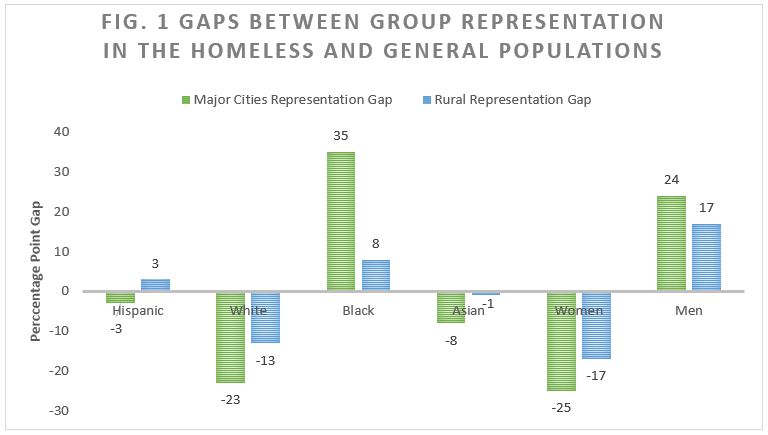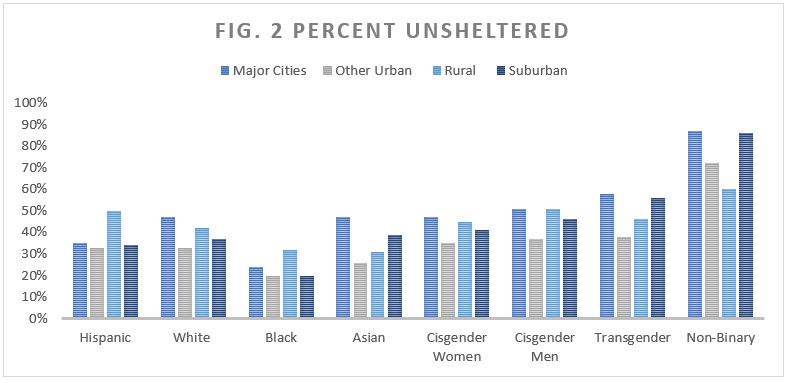Other installments of this series focus on the racial, ethnic, and gender demographics of homelessness in America. They explore similarities and differences among groups. In this brief, we add a new layer to the analysis—geography.
Demographic factors can vary according to where people live – major cities, “other urban” areas (smaller cities), suburbs, or rural areas. Major cities are places where Black/White representation within homelessness is least equitable. (“Other urban” areas) have the lowest unsheltered rates generally and across almost all demographic groups. Rural communities stand out as having high representations of women and White Americans. And, finally, suburbs tend not to be outliers in any significant way.
Rural
In rural America, group representation within homelessness closely mirrors group representation within the general population. For example, White people in rural communities are 84 percent of the general population and 71 percent of the homeless population. This 13-percentage point under-representation in the homeless population is relatively small—especially when compared to major cities where there is a 23-point gap. Similarly, in rural areas, the Black American over-representation gap is a relatively modest 8 percentage points.
Black/White inequities in experiencing homelessness are the least pronounced in rural communities. It should be noted, however, that these numbers do not reflect the role that race plays in other aspects of homelessness and related services.
Other demographic factors stand out in rural areas.
- White Americans. Rural areas have the highest number of White people experiencing homelessness. More than 1 in 3 are in these communities.
- Hispanics/Latinxs. At the national-level, Hispanics/Latinxs are overrepresented within homelessness. Rural and suburban communities are the reasons why. Overrepresentation only occurs in these areas.
Hispanics/Latinxs are also the most unsheltered group in rural America. Fifty percent of homeless Hispanics/Latinxs are sleeping outside or in other places not fit for human habitation. This rate far surpasses that of other groups in rural areas, including White people (42 percent unsheltered), Black people (32 percent unsheltered), and Native Americans (38 percent unsheltered).
- Women represent a larger percentage (34 percent) of the homeless individual population in rural than in other areas. In all other community types, female representation is lower, ranging between 27 and 28 percent.

In general, the percentage of residents experiencing homelessness is rural areas is small when compared to other geographic categories—in other words, the rate of homelessness is low. Rates of homelessness are relatively low across all racial, ethnic and gender groupings.
Nevertheless, homelessness remains a genuine challenge in rural areas, and they face unique complications on the road to ending it. Homeless people in rural areas are often spread across vast geographic areas where residents are less concentrated and more spread out, making it harder to count and serve them (See USICH 2018).
Major Cities
Major cities, when compared to the other geographic categories, have the highest housing costs and the most significant amount of income inequality (See NLIHC 2019; Glassman 2017). In these areas, people of color experience economic and various other disadvantages (NUL 2017). Such challenges coincide with distressing statistics on homelessness.
Only 25 percent of Americans live in major cities, but 50 percent of people experiencing homelessness are in these areas. Thus, rates of homelessness are elevated. This is true across all the racial, ethnic and gender groupings. The highest single group rate of homelessness occurs in major cities—104 out of every 10,000 Black people in major cities are homeless.
In one significant respect, major cities are the inverse of rural areas. While in rural areas the percentage of both Black and White people who are homeless is the smallest relative to their share in the overall population, in urban areas it is the largest relative to their share of the general population. The other two geographic areas fall in between. (See Figure 1).
White people are significantly underrepresented in the homeless population of major cities. They are 38 percent of the homeless population and 61 percent of the general population. This 23-percentage point gap is the highest of all the geographic region types. Meanwhile, overrepresentation within homelessness occurs among Black people in major cities. The group’s astounding 35-percentage representation gap is the highest of all the other geographic regions.
Many homeless people in major cities are unsheltered. Some racial and ethnic groups have the highest risk of unsheltered homelessness in major cities. They include American Indians (63 percent unsheltered in major cities), White Americans (47 percent), and Asians (47 percent).

Other Urban
The “Other Urban” category includes a small number of relatively small cities such as Mobile, Alabama; Stockton, California; Des Moines, Iowa; Cambridge, Massachusetts; Saint Paul, Minnesota; and Amarillo, Texas. These regions stand out for two reasons: 1) an ability to provide shelter and 2) relatively minimal family homelessness.
These “other urban” areas have the lowest percentage of unsheltered people. This reality extends across every racial, ethnic, and gender grouping except non-binary individuals (See Figure 2). Members of all other groups are more likely to have shelter in an “other urban” area than in a major city, rural area, or suburb.
The representation of people in families within homelessness is lowest in “other urban” communities. This is true across multiple racial and ethnic groups, including Hispanics, White people, and Black people.
Suburban
One in four people experiencing homelessness is in suburbs, making these communities second only to major cities in their homeless counts. Despite these numbers, suburbs do not stand out in any significant ways. Racial and gender disparities exist but are not extreme. People are unsheltered, but percentages tend to be neither high or low relative to the other geographic categories.
About this Data
The data in this brief comes from HUD’s 2018 Point-in-Time Count. It is collected by Continuums of Care (CoCs, which are local bodies that coordinate homeless assistance), informing local efforts and being aggregated into an annual report published by HUD. The information is self-reported by consumers or based on the observations of staff/volunteers conducting surveys for the Count. The data may also be extrapolated to estimate a total number of people experiencing homelessness in areas too large for a full street count.
Because CoCs report the data to HUD in aggregate, there are limitations on the ability to fully analyze the data at the intersections of identity. For example, we are unable to produce analysis that focuses on Black women or men over the age of 55.
The geographic categories used in this brief (major cities, other urban, suburban, and rural) are the ones used by HUD in its Annual Homeless Assessment Report (AHAR). The categorization system is imperfect. For instance, Balance of State Continuums of Care are labeled “rural” but may include populous towns. And rural areas may be a part of CoCs that are labeled as “other urban” or some other category.
The data used in this series is the most comprehensive country-wide data available on the racial and gender demographics of homelessness. It should be used to foster a discussion in each community and as a conversation piece for reaching out to experts in the area.
Works Cited
Glassman, Brian. (2017). Income Inequality among Regions and Metropolitan Statistical Areas: 2005 to 2015. New York City: U.S. Census Bureau.
National Low Income Housing Coalition (NLIHC). (2019). Out of Reach.
National Urban League (NUL). (2017). State of Black America 2017: Protect our Progress.
United States Interagency Council on Homelessness (USICH). (2018). Strengthening Systems for Ending Rural Homelessness: Promising Practices and Considerations.
Stay Updated: Solutions, Stories, and Ways to Make an Impact
Sign up to receive updates on the Alliance’s work, including the latest research, advocacy efforts, and real stories of progress — plus ways you can help drive lasting change.











